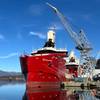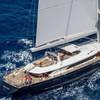Maryland’s far Eastern Shore may soon be a quick trip from Baltimore, thanks to a ferry being developed by Maritime Applied Physics Corporation and A. James Clark School of Engineering researchers through the Maryland Industrial Partnerships Program.
The plane-like boat, which could be in service year-round as early as summer 2007, will fly passengers 18 miles over the water from Rock Hall to Baltimore or back for potential shopping trips, coastal touring, evening dinners, Orioles games, cultural events, and commuting to work.
“Since the steamship days the Eastern Shore has held a certain allure for Baltimoreans,” said P.A.M. Schaller, Director of Economic Development for Kent County. “Rock Hall has the flavor of a waterman’s town. Nearby Chestertown has loads of 18th century architecture. Both have fabulous restaurants. It’s like stepping back in time.”
The trip by car is 80 miles, requiring a drive either north into Delaware, or south to the Chesapeake Bay Bridge.
Passenger ships ran the same route as recently as the 1960s, according to Schaller. A 155-acre amusement park called Tolchester Beach north of Chestertown serviced a ferry and as many as six steamers, attracting 22,000 visitors a weekend. The 85-year-old park closed in 1962.
Rock Hall and its neighboring areas are getaway havens, with booming summer communities of vacationing boaters from Philadelphia, Delaware, New Jersey, and New York.
The new, 80-passenger ferry will be part plane—flying close to the water, lifted into the air by its aerodynamic hull; it will be part hydrofoil, a type of boat with wing-shaped blades attached to struts under the hull that lift the boat out of the water as speed increases; it will also be part luxury vessel, with leather aircraft seating, a coffee bar, and outlets for laptops.
The ride will be smooth. Hydrofoils are used by militaries worldwide to effortlessly glide over high waves.
The boat’s hull design, unlike any other vessel, will make it perform like an aircraft. That’s where Jewel Barlow, director of the University’s Glenn L. Martin Wind Tunnel, comes in.
“The hull we’re creating is shaped like a wing to create lift, much like a plane, at low clearances above the water,” Barlow explained. “This lift, occurring as the boat reaches high speeds, will support the weight of the ship and reduce drag while avoiding reverse lift, which would push the boat back down into the water.”
No other commercial hydrofoil-based ferry on the market produces this kind of lift, according to Mark Rice, president of MAPC. Less drag, he explained, means less fuel consumption, which means lower trip costs, and possible speed boosts. The ferry could go as fast as 68 miles-per-hour.
“We’re trying to get the fuel-used-per-passenger-mile ratio down,” Rice explained. “We’d like the ferry to perform at least 25 percent better than the Boeing JETFOIL, the most technically advanced passenger hydrofoil ever built.”
That efficiency would make MAPC a world-leading innovator in hydrofoil ferries.
“The intent is to find products made in the U.S. with a performance advantage that allow you to sell overseas,” said Rice. “You can’t go head-to-head with Asian builders on a product that can be built there for less. You have to add enough technical value to make up for the difference in purchase cost.”
MAPC plans to build the first ten ferries, selling each for approximately $2 million.
Future high-speed ferry routes could include trips from Baltimore to Annapolis, St. Michaels to both Baltimore and Annapolis, and Cambridge to Annapolis. Similar routes in the U.S. are in Boston (to Martha’s Vineyard), Seattle’s Puget Sound, San Francisco Bay, Long Island Sound, and Scotia. Many European and Asian ports also feature passenger ferry services.
Sponsored Content
MSC Sets a New Standard for Time Off in 2025, Plus Earn a $38,340 Bonus as an Able Seaman!

Navigate Compliance with Confidence: Discover Carbon Diligence from ABS Wavesight

Featured videos

Xenos Marine Takes Aim at the Gulf Salvage, Decommissioning Markets

AI to the Rescue: Zelim’s ZOE to be Installed on Cruise Ship
April 2025
 Read the Magazine
Read the Magazine

 Read the Magazine
Read the Magazine
This issue sponsored by:

OPINION: Hold the Bricks, Start the Discussion on the Future of Domestic Shipbuilding
Subscribe for
Maritime Reporter E-News
Maritime Reporter E-News is the maritime industry's largest circulation and most authoritative ENews Service, delivered to your Email five times per week









